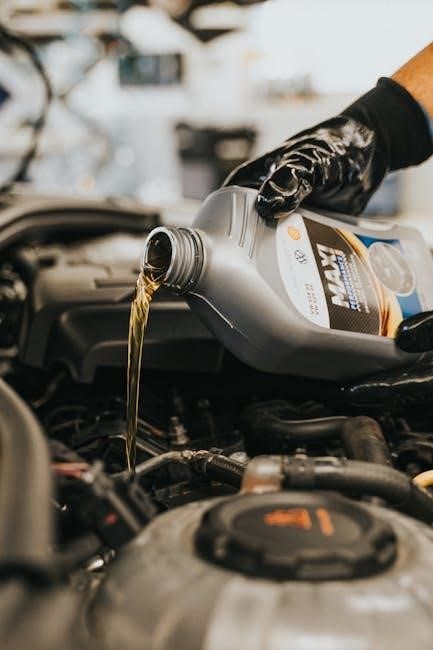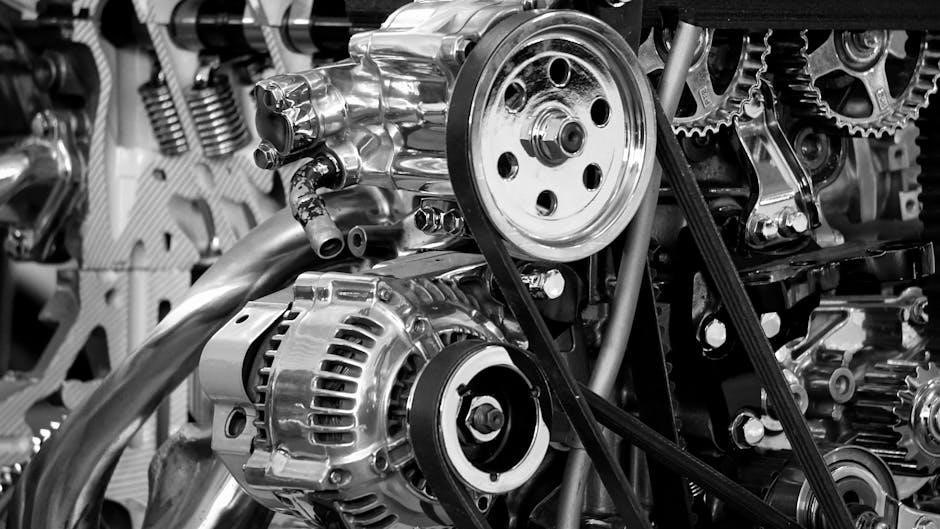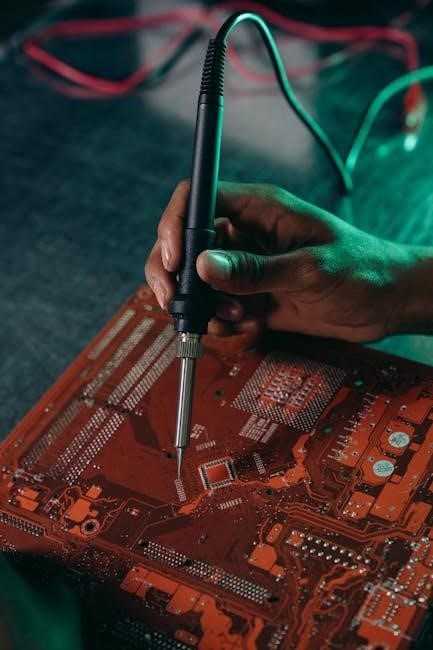Flat rate pricing offers a fixed cost for specific repairs‚ ensuring transparency and efficiency. It helps small engine repair businesses remain competitive while providing clear‚ upfront pricing to customers.
1.1 What is Flat Rate Pricing?
Flat rate pricing is a payment structure where customers are charged a fixed amount for specific repair services‚ regardless of the time taken. This approach differs from hourly rates‚ as the cost remains consistent for predefined tasks. For example‚ an oil change or carburetor cleaning might have a set price‚ ensuring transparency and predictability. This method is popular in small engine repair as it simplifies billing and helps build trust with customers‚ who appreciate knowing the exact cost upfront.
1.2 Benefits of Flat Rate Pricing for Small Engine Repair
Flat rate pricing offers numerous benefits for small engine repair businesses. It ensures consistent earnings by standardizing payment for common tasks‚ reducing customer disputes over time spent. This model also simplifies pricing transparency‚ making it easier for customers to budget and understand costs. Additionally‚ flat rates can increase efficiency as technicians focus on completing tasks quickly‚ knowing they are compensated fairly. Overall‚ it fosters trust and customer satisfaction‚ which are crucial for building a loyal client base and maintaining a competitive edge in the market.
Understanding Hourly Rates in Small Engine Repair
Hourly rates are calculated based on labor time and shop rates‚ varying by location‚ expertise‚ and repair complexity‚ providing a flexible pricing structure for services.
2.1 Average Hourly Rates for Small Engine Repair
Average hourly rates for small engine repair typically range between $40 to $100 per hour‚ depending on location‚ mechanic expertise‚ and shop overhead. Urban areas often see higher rates due to increased demand and operational costs‚ while rural areas may offer more competitive pricing. Experienced technicians or specialized shops may charge premium rates for complex repairs. Factors like diagnostic time‚ labor intensity‚ and required certifications also influence hourly rates. Understanding these averages helps in setting flat rates that remain competitive and fair for both businesses and customers.
2.2 Comparing Flat Rate Pricing to Hourly Rates
Flat rate pricing offers a fixed cost per repair‚ eliminating variability based on time taken. Unlike hourly rates‚ which can fluctuate depending on the technician’s speed and complexity‚ flat rates provide customers with upfront clarity. This model often benefits routine or predictable repairs‚ ensuring customers know exact costs beforehand. Hourly rates may penalize customers for unforeseen issues‚ while flat rates incentivize efficiency without compromising quality. Both models have merits‚ but flat rates tend to enhance customer trust and simplify budgeting for small engine repair services.

Standard Repair Times for Common Small Engine Repairs
Standard repair times are established to provide consistency in pricing and labor estimation‚ ensuring fair pricing and efficient service delivery.
3.1 Oil Changes and Routine Maintenance
Oil changes and routine maintenance are essential for small engine longevity. Typically‚ these services take 30 minutes to an hour‚ depending on the engine type. Flat rate pricing simplifies billing‚ covering oil‚ filters‚ and labor. Routine maintenance often includes spark plug checks‚ air filter cleaning‚ and lubrication of moving parts. Flat rate systems ensure transparency‚ allowing customers to budget effectively. Shops can complete jobs faster‚ knowing the fixed time allocated for such tasks. This approach streamlines operations and enhances customer satisfaction by providing clear‚ upfront costs.
3.2 Carburetor Cleaning and Repair
Carburetor cleaning and repair is a common small engine service‚ often taking 1 to 2 hours. Flat rate pricing for this job typically ranges from $50 to $150‚ depending on complexity. The process involves disassembling‚ cleaning‚ and reassembling the carburetor‚ ensuring proper fuel flow. Additional costs may apply for replacing worn-out parts like gaskets or jets. Flat rate pricing simplifies billing‚ covering labor and materials upfront. This approach helps customers avoid unexpected charges and ensures quick turnaround for essential repairs.
3.3 Tire Repairs and Bearing Replacements
Tire repairs and bearing replacements are essential for small engine equipment mobility. Flat rate pricing for tire repairs typically ranges from $20 to $50‚ depending on the extent of damage or wear. Bearing replacements‚ often more labor-intensive‚ are priced between $30 to $75 per bearing. The process involves removing the wheel‚ inspecting the bearing‚ and reinstalling a new one. Additional charges may apply for tire dismounting or balancing. Flat rates ensure customers know upfront costs‚ streamlining the repair process and reducing billing complexities. This approach is ideal for routine maintenance and unexpected repairs.
Manufacturer Repair Guides
Manufacturer repair guides provide detailed instructions and flat rate times for specific small engine models‚ ensuring accurate repairs and consistent pricing across services.
4.1 Briggs & Stratton Repair Guide
The Briggs & Stratton repair guide offers detailed flat rate times and diagnostic tips for small engines‚ helping technicians estimate repairs accurately. It covers models like Vanguard and Intek‚ providing standardized labor times for common repairs. This guide ensures consistency in pricing and service quality‚ allowing technicians to quote customers confidently. By following the guide‚ repairs become more efficient‚ reducing guesswork and ensuring customer satisfaction. It’s a valuable resource for maintaining transparency and trust in flat rate pricing for small engine services.
4.2 Kawasaki and Other Manufacturer Guides
Kawasaki and other manufacturer guides provide flat rate times and diagnostic tips for small engines‚ helping technicians estimate repairs efficiently. These guides cover models like the Kawasaki FX and FR series‚ offering standardized labor times for common tasks. They ensure consistent pricing and service quality across repairs. By referencing these guides‚ technicians can maintain transparency and trust with customers. This approach streamlines the repair process‚ reducing uncertainty and ensuring accurate flat rate pricing for small engine services.
Pricing Strategies for Independent Contractors
Independent contractors can set competitive flat rates by analyzing local market demands and adjusting based on service complexity. Offering bundled services or discounts attracts more customers effectively.
5.1 Setting Competitive Rates
To set competitive rates‚ research local market pricing for small engine repairs. Analyze competitors’ flat rates and adjust accordingly. Consider labor costs‚ parts‚ and overhead to ensure profitability. Understand customer willingness to pay and tailor rates to reflect service quality. Seasonal demand fluctuations may require rate adjustments. Transparent pricing builds trust‚ so clearly communicate rates upfront. Balance affordability with profitability to attract customers while maintaining business sustainability. Regularly review and update rates to stay aligned with market trends and customer expectations.
5.2 Sliding Scale Pricing Models
A sliding scale pricing model adjusts rates based on repair complexity‚ customer type‚ or service volume. This approach offers flexibility‚ allowing you to charge higher rates for complex jobs and lower rates for simpler or bulk repairs. For example‚ residential clients might receive standard rates‚ while commercial clients or frequent customers could benefit from discounted pricing. This model enhances customer satisfaction by tailoring costs to individual needs‚ fostering loyalty and long-term relationships. It also allows you to capture more business by accommodating diverse customer segments effectively.

Customer Perception and Pricing Transparency
Transparency in pricing builds trust‚ as customers appreciate knowing upfront costs. Clear communication of flat rates reduces concerns‚ fosters satisfaction‚ and ensures fairness‚ enhancing customer loyalty.
6.1 Addressing Customer Concerns About Pricing
Customers often question flat rate pricing‚ fearing hidden costs or overcharging. Address concerns by explaining how flat rates are based on standard repair times‚ ensuring fairness. Provide detailed breakdowns of services and emphasize that upfront pricing eliminates surprises. Listen to objections and offer solutions‚ such as reviewing the repair guide together. Transparency builds trust‚ making customers more likely to accept flat rates. Clear communication and patience are key to resolving pricing concerns effectively.
6.2 Offering Quotes Without Hourly Rate Disclosure
Providing quotes without disclosing hourly rates focuses on transparency while protecting your pricing structure. Clearly outline the total cost and what’s included‚ ensuring customers understand the value. Avoid mentioning hourly rates‚ as it may lead to pricing debates. Instead‚ emphasize the flat rate’s predictability and convenience. Offer detailed estimates and explain how the flat rate is derived from standard repair times. This approach builds trust and simplifies the decision-making process for customers‚ making them more likely to accept your quote without questioning the rate structure.
Book Rates and Labor Times
Book rates and labor times provide standardized estimates for repairs‚ helping technicians and customers understand expected durations and costs. They ensure consistency and accuracy in pricing.
7.1 What Are Book Rates?
Book rates refer to standardized labor times provided by manufacturers or industry guides for specific repairs. These rates estimate the time required for a skilled technician to complete a task under normal conditions. They are based on average expertise levels and do not account for diagnostics or unexpected complications. For example‚ a book rate might specify 1.5 hours for an oil change or 3 hours for a carburetor replacement. These rates help technicians and customers understand expected labor durations‚ ensuring transparency and consistency in pricing and time management.
7.2 How to Use Book Rates for Estimating Repair Times
Book rates are essential for accurately estimating repair times. Start by identifying the specific repair from the manufacturer’s guide. Look up the corresponding book rate‚ which provides the standard time for the job. Add any additional time for diagnostics or unexpected issues. Use these rates to create detailed estimates‚ ensuring transparency with customers. This method helps in setting fair labor costs and managing workflow efficiently. By referencing book rates‚ technicians can provide consistent and reliable time estimates‚ enhancing customer trust and streamlining repair processes.

Common Repairs and Their Flat Rates
Common small engine repairs include routine maintenance‚ carburetor cleaning‚ and spark plug replacements. Flat rates simplify billing‚ ensuring customers know exact costs upfront for standard services.
8.1 Lawnmower Repair Pricing
Lawnmower repair pricing varies based on the type of repair. Blade sharpening typically costs between $10 to $20‚ while oil changes range from $20 to $40. Carburetor cleaning or replacement can cost $50 to $150‚ depending on complexity. Flat rates for lawnmower repairs ensure customers receive upfront pricing‚ eliminating surprises. Average flat rates for common issues like spark plug replacements or air filter cleaning range from $15 to $50. These rates are designed to cover labor and parts efficiently‚ offering transparency and convenience for homeowners;
8.2 Small Engine Overhaul Costs
A small engine overhaul involves rebuilding or replacing major components like seals‚ gaskets‚ pistons‚ and rings. Flat rate pricing for overhauls typically ranges from $200 to $600‚ depending on the engine size and brand. For example‚ a Briggs & Stratton or Honda engine overhaul might cost $300 to $500‚ while larger engines or premium brands may exceed $600. Labor costs are included in flat rates‚ offering customers a clear‚ upfront price for comprehensive repairs. This approach ensures transparency and helps budget planning for significant engine work.
Pricing for Specific Services
Zero-turn mower servicing and push mower maintenance are priced at $75 to $150 and $50 to $100 respectively‚ offering clear‚ upfront costs for specific tasks.
9.1 Zero-Turn Mower Servicing
Zero-turn mower servicing typically includes blade sharpening‚ tire pressure checks‚ and hydraulic system inspections. Flat rates range from $75 to $150‚ depending on the model and complexity. Additional services like deck cleaning or belt replacements may add $20-$50. This pricing structure ensures transparency‚ allowing customers to budget effectively without hidden costs. Many technicians also offer seasonal packages‚ combining servicing with storage preparation for a discounted flat rate. This approach enhances customer satisfaction and loyalty‚ as clients appreciate the upfront‚ all-inclusive pricing for their zero-turn mowers.
9.2 Push Mower Maintenance
Push mower maintenance typically includes oil changes‚ blade sharpening‚ and spark plug replacements. Flat rates range from $50 to $90‚ depending on the mower size and complexity. Additional services like air filter cleaning or deck cleaning may add $10-$20. This pricing model ensures quick turnaround times and upfront costs for homeowners. Many shops offer package deals for routine maintenance‚ making it a cost-effective option. Flat rate pricing for push mowers is popular due to its simplicity and transparency‚ allowing customers to avoid unexpected charges.

Seasonal Demand and Pricing Adjustments
Seasonal demand significantly impacts flat rate pricing for small engine repairs. Peak seasons‚ like spring and summer‚ often see higher rates due to increased workload and urgency. Off-season discounts attract customers during slower periods‚ ensuring steady business year-round. Adjustments are strategic to balance supply and demand while maintaining profitability. This approach helps small engine repair shops remain competitive and sustainable throughout the year.
10.1 High-Demand Seasons for Small Engine Repair
Spring and summer are peak seasons for small engine repair due to increased use of lawnmowers‚ trimmers‚ and other outdoor equipment. Customers rush to prepare their gear for the growing season‚ creating high demand. Similarly‚ fall sees a surge as equipment requires servicing before winter storage. These periods often lead to longer wait times and higher workloads for repair shops.
Understanding these seasonal fluctuations is crucial for setting flat rates. Shops may adjust pricing or offer incentives during off-peak times to maintain steady business. This strategy ensures profitability and customer satisfaction year-round.
10.2 Adjusting Rates Based on Seasonality
Seasonal demand fluctuations allow repair shops to adjust flat rates strategically. During peak seasons‚ such as spring and summer‚ rates can be slightly increased to reflect higher demand and faster turnaround needs. Conversely‚ during slower months‚ offering reduced rates or promotions can attract customers and maintain workflow. This flexible pricing approach helps balance profitability while keeping services affordable and competitive.
Clear communication about seasonal rate adjustments ensures customer understanding and satisfaction‚ fostering long-term trust and loyalty.

Discounts and Promotions
Discounts and promotions are effective strategies to attract customers and ensure satisfaction. Offering bulk repair discounts‚ loyalty programs‚ and seasonal specials can enhance customer retention and boost sales.
11.1 Offering Discounts for Bulk Repairs
Offering discounts for bulk repairs can attract customers with multiple small engines to service. Providing a percentage-based discount or fixed-rate reduction for multiple repairs incentivizes customers to bring in more equipment. This approach not only increases workshop efficiency but also builds customer loyalty. For example‚ offering a 10% discount for three or more engines serviced simultaneously can encourage larger orders. Promoting such deals during off-peak seasons can help maintain steady workflow and customer engagement.
11.2 Promotional Pricing Strategies
Promotional pricing strategies can effectively attract customers and boost business during slow periods. Tactics like seasonal discounts‚ bundle deals‚ or limited-time offers create urgency and encourage customers to book repairs. For instance‚ offering a “summer tune-up special” for lawnmowers or discounted services for first-time customers can drive engagement. These strategies help fill gaps in workload and increase customer loyalty. Clear communication of promotions through social media‚ email‚ or flyers ensures visibility and maximizes impact. Balancing promotions with profitability is key to sustaining business growth.

Tools and Resources for Flat Rate Pricing
Essential tools and resources for flat rate pricing include repair manuals‚ pricing guides‚ and industry-standard software to ensure accurate and efficient repair estimates for small engines.
12.1 Repair Manuals and Guides
Repair manuals and guides are indispensable for flat rate pricing‚ providing detailed labor times and procedures for small engine repairs. These resources‚ often produced by manufacturers like Briggs & Stratton or Kawasaki‚ outline standard repair times‚ ensuring consistency and accuracy. Technicians rely on these manuals to estimate labor costs efficiently‚ avoiding under or overcharging customers. By referencing these guides‚ repair shops can maintain transparency and fairness in pricing‚ ensuring customer trust and satisfaction with the flat rate system.
12.2 Online Pricing Guides for Small Engine Repair
Online pricing guides provide essential data for flat rate pricing‚ offering detailed labor times and estimated costs for small engine repairs. Platforms like RepairPal or iSeeCars often include specific repair estimates‚ helping technicians and businesses set competitive rates. These guides also outline parts costs and average labor hours‚ ensuring transparency and accuracy. By leveraging these tools‚ repair shops can maintain consistency in pricing‚ enhance customer trust‚ and streamline the estimation process for various small engine services.
Building Customer Relationships
Building strong customer relationships requires trust and transparency‚ especially with flat rate pricing. Clear communication about pricing and consistent service fosters loyalty and positive reviews.
13.1 The Importance of Trust in Pricing
Trust is crucial for customer loyalty in small engine repair. Flat rate pricing eliminates surprises‚ ensuring customers know costs upfront. Transparent pricing builds credibility‚ reducing skepticism and fostering long-term relationships. Consistent‚ fair rates demonstrate reliability‚ encouraging repeat business and referrals. Open communication about pricing strengthens trust‚ making customers more likely to trust your expertise and recommend your services to others. A trustworthy pricing model is essential for sustaining a loyal customer base and growing your reputation as a reliable small engine repair provider.
13.2 Ensuring Customer Satisfaction with Flat Rates
Flat rate pricing enhances customer satisfaction by providing upfront‚ predictable costs. Customers appreciate knowing the exact price before work begins‚ eliminating surprises. This clarity reduces anxiety and builds confidence in your services. By ensuring repairs are completed efficiently within the agreed timeframe‚ you meet expectations and encourage positive feedback. Offering a warranty on parts and labor further reinforces trust. Satisfied customers are more likely to return and recommend your services‚ fostering long-term loyalty and business growth through transparent‚ customer-centric pricing practices.

Payment Terms and Policies
Clear payment terms enhance customer trust. Offer flexible methods like cash‚ credit‚ or checks. Require payment upon completion or set a due date for invoices. Late fees may apply. Ensure transparency in billing.
14.1 Minimum Charge Policies
Implementing a minimum charge policy ensures fairness for small repairs. Typically‚ $20-$50 covers basic diagnostics or minor fixes. This policy applies even if the repair takes less time than expected. It helps cover overhead costs and technician expertise. Clearly communicate this policy to customers upfront to avoid disputes. Transparency builds trust and ensures smooth transactions. Adjust the minimum charge based on local market rates and service complexity. Consistency is key to maintaining customer satisfaction and business profitability.
14.2 Payment Methods and Terms
Offering flexible payment methods enhances customer convenience. Accept credit cards‚ cash‚ and checks. Digital payment options like PayPal or Venmo are increasingly popular. Clearly outline payment terms‚ such as due upon completion or deposit requirements. Provide detailed invoices with itemized charges. Ensure payment policies are communicated upfront to avoid misunderstandings. Offering financing options or payment plans can attract more customers. Stay updated on payment trends to accommodate diverse preferences. Transparent billing builds trust and encourages repeat business.

Starting a Small Engine Repair Business
Starting a small engine repair business requires a strategic plan‚ proper tools‚ and licensing. Conduct market research‚ assess competition‚ and hire skilled technicians. Focus on excellent customer service‚ branding‚ and financial planning for long-term success.
15.1 Pricing Considerations for New Businesses
When starting a small engine repair business‚ pricing is critical. New businesses should research local market rates and competition to set competitive flat rates. Analyze labor costs‚ parts‚ and overhead to ensure profitability. Consider offering introductory discounts to attract initial customers and build loyalty. Transparency in pricing helps establish trust. Track repair times and adjust rates as needed to reflect actual labor and material costs. Regularly review pricing strategies to stay competitive and profitable in the long term.
15.2 Marketing Your Flat Rate Services
Effectively marketing flat rate services is key to attracting customers. Highlight the transparency and predictability of flat rate pricing in your advertising. Use social media‚ flyers‚ and local partnerships to promote your services. Offer free quotes and showcase before-and-after photos of repairs. Build trust by sharing customer testimonials and emphasizing your expertise. Consider email newsletters to keep customers informed about promotions and seasonal offers. Ensure your website is professional and SEO-optimized to reach a wider audience. Clear communication of your flat rate benefits will help differentiate your business from competitors.

Future Trends in Flat Rate Pricing
Advancements in technology‚ like AI-driven repair estimation tools‚ will enhance accuracy and efficiency in flat rate pricing for small engine repairs‚ ensuring transparency and customer satisfaction.
16.1 Technological Advancements in Repair Estimation
Technological advancements are revolutionizing repair estimation in small engine repair. Mobile apps and software now provide instant access to repair guides‚ enabling technicians to generate accurate quotes quickly. AI-powered tools predict repair times and estimate costs based on historical data. Real-time diagnostic tools integrated with repair databases ensure precise labor time estimates. Automation reduces human error and speeds up the estimation process. These innovations enhance transparency‚ improve customer trust‚ and streamline workflows for small engine repair businesses.
16.2 Consumer Expectations and Pricing Transparency
Consumers increasingly demand transparency in pricing‚ expecting clear upfront costs for small engine repairs. This shift is driven by digital tools that provide instant estimates‚ fostering trust. Repair shops must adapt by offering detailed breakdowns of flat rates‚ ensuring customers understand what they’re paying for. Transparency not only builds trust but also enhances competitiveness‚ as customers are more likely to choose providers who openly share pricing. This approach ensures customer satisfaction and long-term loyalty in a market where clarity is valued.